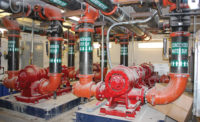“This Library will belong to the people of the United States,” observed Harry S. Truman in 1954, reflecting on his future presidential library in Independence, MO [https://trumanlibrary.org/libhist.htm]. “The papers of the Presidents are among the most valuable sources of material for history. They ought to be preserved, and they ought to be used.”
The Harry S. Truman Presidential Library & Museum was dedicated in 1957. For over 60 years, a team of curators, archivists, and conservators has worked to preserve President Truman’s material legacy. Recently, a team of engineers and contractors designed and installed a new central chilled water plant and dehumidification system that is creating the optimal indoor environment to preserve and display the collections.
Article Index:
- Engineered to Maintain a Controlled Environment
- Strategic Imperative: Provide Continuous Cooling
- Space Constraints Require Ingenuity
- BIM/Detailing, Prefabrication Streamline Installation
- Effective Coordination Facilitates a Successful Project
The installation of the new central chilled water plant and dehumidification system posed a number of project challenges for the mechanical installation contractor, EMCOR Services Fagan, a subsidiary of EMCOR Group Inc. These challenges included the requirements to provide a temporary source of continuous chilled water and tempered air for the comfort of occupants and visitors, and to maintain a stable relative humidity in the archive rooms throughout the project — February through September 2015 — all while enabling full library operations during the installation. Given the building’s design and historical value, the installation required maneuvering equipment through and into tight spaces with the utmost care in order to preserve building structure and finishes.
To put these challenges in perspective, the Truman Library receives 6,700 visitors monthly on average. The collection houses approximately 15 million pages of manuscript materials (including 6.5 million White House files); an audiovisual collection including 128,000 still pictures (1,300 hours of audio recordings, 500 motion pictures, and 1,000 hours of video tape recordings); a collection of printed materials (including more than 10,000 books); more than 500 transcribed oral history interviews; and approximately 32,000 objects (primarily gifts to President and Mrs. Truman).
Engineered to Maintain a Controlled Environment
The 100,000-sq-ft building, which has a full basement, is heated and cooled through a central chilled water plant and steam heating boiler plant with distribution throughout the building to AHUs. It appeared that the existing chilled water plant equipment was at the end of its useful life. The engineer of record used the dehumidification system as the basis of design for the library’s upgraded mechanical system.
Major components of the new system include: three dehumidification AHUs (4,410 cfm in historical presidential document collection storage, 7,625 cfm in library stacks, and 1,530 cfm in furniture collection storage); two 200-ton electric water-cooled chillers; three new 305-gpm chilled water pumps; and a 7,700 cfm AHU. The dehumidification units are designed to maintain the indoor environment at a consistent 30% to 40% rh throughout the year to preserve library documents and other materials and objects in the collections.
The main project objectives under EMCOR Services Fagan’s contract were the installation of the new central chilled water plant, including new water-cooled chillers with magnetic compressors and new chilled water pumps; replacement of two chilled water/steam variable-speed AHUs with the new dehumidifying AHUs; and replacement of a chilled water/steam variable-speed AHU with a chilled water/hot water AHU.
Strategic Imperative: Provide Continuous Cooling
Planning revolved around the challenging project requirement of providing continuous chilled water and 70-degree air to areas of the library that would be affected by mechanical component change-outs. In the first phase, the mechanical installation team established a temporary chiller plant outside of the library in a location that would not be visible to library patrons. The temporary plant was comprised of a temporary 300-ton air-cooled chiller, temporary chilled water pump, and one of two temporary AHUs. Temporary chilled water piping and ductwork were run into the building and tied into the existing mechanical system.
To save on schedule and budget, the second temporary AHU was installed in the mechanical room — a tight space. The temporary AHUs were purchased with a specific unit orientation required to meet existing utility requirements: a stacked chilled water coil with an EMCOR Services Fagan shop-fabricated mixing box, which utilized the company’s piping and sheet metal building information modeling (BIM)/detailing and shop-fabricating capabilities.
Because the library did not have sufficient electrical power available to supply the existing and temporary chiller plants, the EMCOR Services Fagan team installed a temporary diesel generator to meet the power requirements. After the team internally commissioned all of the temporary systems to verify performance, the electrical contracting team switched the power feed from the existing chillers to the temporary chiller plant so that it could be run off building power instead of diesel generation. The generator was retained as an emergency back-up power source.
In the second phase of the mechanical installation project, the EMCOR Services Fagan team began work on demolition and replacement of existing mechanical system components.
Space Constraints Require Ingenuity
There were many space constraints within the library, including dimensional restrictions in the route of travel through the library and within mechanical rooms, where the installation involved new steam-to-hot water converters and pumps, new electric humidifiers, and a new reverse osmosis water system to supply the humidifiers — more equipment than had previously occupied the space.
The installation of the new central chilled water plant in the basement involved the removal of the existing chillers and installation of the two new chillers on the same housekeeping pad and, similarly, the removal of the existing chilled water pumps and installation of the two new chilled water pumps on the same housekeeping pad.
The height of the new chillers did not allow the use of conventional rollers beneath chiller baseplates, requiring a nonconventional way to move the new chillers through the building and in and out of the elevator to the basement. To solve this problem without resorting to removal of two compressors on each unit, the mechanical installation team designed and fabricated a cradle with wheels to support the chiller barrels and used jack screws to lift the baseplate a mere half-inch off the floor and roll it through the building.
To serve historical presidential documents collection storage, library stacks, and furniture collection storage with dehumidified air, the mechanical installation team replaced the existing AHUs with the new units. Like the chillers, one of these units — the 7,625-cfm dehumidifying unit serving the library stacks — was too large to move through the building. The team called in the manufacturer to supervise the disassembly of the unit outside the building, transport to the basement, and reassembly in place in the mechanical room. The new equipment was tied back into existing ductwork serving the library stacks.
BIM/Detailing, Prefabrication Streamline Installation
To streamline the mechanical installation of the new systems in tight spaces, as well as to meet the project budget and schedule, EMCOR Services Fagan utilized its piping and sheet metal BIM/detailing and shop-fabricating capabilities in several additional key ways. To fit available space in two mechanical rooms, the company designed and prefabricated steam-to-hot-water skids that include steam-to-hot water converters, hot water pumps, air separators and piping — in each case, reducing the amount of floor space required for the components by 50% and saving approximately 12 working days in the installation schedule.
EMCOR Services Fagan also detailed and prefabricated 6- and 8-in central chilled water piping and condenser water piping for the new chiller plant, as well as reverse osmosis skids that include water softeners and a storage system. Prefabrication of components using BIM enabled the mechanical installation team to resolve potential conflicts and clashes with other piping or systems, streamlined installation, and reduced the need for on-site welding and associated nuisances to the fully operational library.
Effective Coordination Facilitates a Successful Project
Weekly project coordination meetings involving various members of the larger Truman Library project team — including those from the engineer of record, the general contractors, and EMCOR Services Fagan — helped ensure that the project proceeded according to plan with minimal impact on library operations. Moreover, interaction with the library’s director, as well as the maintenance staff, were invaluable in helping the team to identify and respond in a timely way to operational and building systems questions.
In June 2017, the Kansas City Chapter of the MCA (Mechanical Contractors Association) recognized EMCOR Services Fagan with its top award for “Outstanding Mechanical Installation.”
In the end, it was the combined commitment, experience, technical expertise, and financial strength of the entire project team helping the dedicated curators, archivists, and conservators of the Harry S. Truman Library preserve the 33rd president’s material legacy for the people of the United States — just as he envisioned in 1954.





